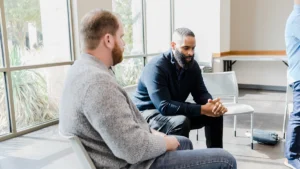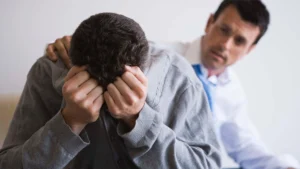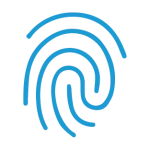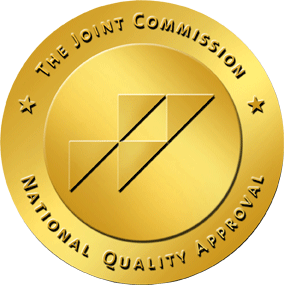Finding the right depression treatment centers near you can feel like a big step, but it’s also an important one toward feeling better. If you’re dealing with depression, reaching out for help is a sign of strength, and there are many options available to support you.
Below, you’ll learn about different types of treatment centers and how to find the one that fits your needs.

What Is Depression?
First, we’ll tackle what depression is. Depression (major depressive disorder) is more than just feeling sad. Everyone feels down sometimes, but depression sticks around longer and can make it hard to enjoy life. This common mental health condition can affect how you think, feel, and act every day.
Depression doesn’t happen for just one reason. It can come from many factors, like stress, trauma, loss of a loved one, family history, or even changes in your brain or hormones. Sometimes, it shows up without a clear cause at all.
You might notice that your energy is low, or that you don’t want to do things you used to enjoy. Maybe you’re sleeping too much or not enough. Your appetite might change by eating more or less than usual. You might feel worthless, guilty, or even like life isn’t worth living. These feelings can be really heavy and hard to explain.
But help is out there, and things can get better.
Types of Depression Treatment Centers
It’s good to know that different types of treatment centers can help. Each one offers a different level of support, depending on how serious the depression is and what kind of help is needed.
The main types of treatment centers include the following:
1. Inpatient Treatment
This is for people who need a lot of care. You stay at the center full-time, usually for a few days or weeks. Doctors and nurses are there 24/7 to help keep you safe and stable. This is often the best option if someone is thinking about hurting themselves or needs close medical help.
2. Residential Treatment
Residential centers also let you stay there, but it’s not as intense as inpatient care. It’s more like living in a safe, calm place where you get therapy every day, learn new coping skills, and get support from staff and others going through the same thing. It’s helpful if depression is strong and hard to manage at home.
3. Partial Hospitalization Programs (PHP)
With PHP, you spend most of your day at the center, getting therapy and care, but you go home in the evening. It’s like a full-time program during the day. This works well if you need more than regular therapy but don’t need to stay overnight.
4. Outpatient Treatment
Outpatient programs let you live at home and visit the center a few times a week. You might go for therapy, group sessions, or to see a doctor about medication. This is a good choice if your depression is more manageable or if you’re stepping down from a higher level of care.
No matter which type you choose, the goal is the same: to help you feel better, understand your feelings, and learn ways to handle depression. You’re not alone, and there is a kind of care that fits your situation.
What to Expect at a Depression Treatment Center
Going to a depression treatment center can feel a little scary at first, especially if you don’t know what to expect. But knowing what happens there can help you feel more comfortable and prepared.
When you first arrive, someone will talk with you about how you’re feeling. They’ll ask about your symptoms, your health, and your life. This helps them understand what kind of care you need. They might do a simple checkup or ask about any medications you’re taking.
After that, you’ll start a treatment plan that’s made just for you. This plan might include:
1. Psychotherapy (talk therapy or counseling)
You’ll meet with a therapist to talk about your thoughts and feelings. This can help you understand what’s going on in your mind and teach you ways to cope. You might also join group therapy, where you talk with others going through similar struggles. You’ll see that you’re not alone.
2. Medication (if needed)
A doctor may suggest medicine to help balance your mood. If so, they’ll explain how it works and check in to make sure it’s helping you without causing side effects.
3. Daily Routine
Most centers have a schedule to follow each day. This can include therapy sessions, meals, exercise, quiet time, and activities like art, music, or journaling. Having a routine helps your mind and body heal.
4. Support from Staff
You’ll be around caring people, such as nurses, therapists, and counselors, who are trained to help you feel safe and supported.
5. A Safe and Calm Place
Whether you’re staying overnight or just visiting during the day, the center is meant to be a peaceful place where you can focus on getting better.
Remember, the center is there to help you feel stronger and give you tools to handle depression. It’s all right to feel nervous, but many people say it’s one of the best steps they’ve taken toward feeling like.
Matching Programs to Individual Needs
The best kind of help is the one that fits your life, your needs, and your comfort level.
You can find the right match for yourself or a loved one by considering these factors:
1. Choose Care That Fits Their Stage of Life
Some programs are made just for teens, young adults, or older adults. The way people talk about feelings and what they need can be different at each stage of life. It’s helpful to choose a place where the staff understands your age group.
2. Look at How Serious the Depression Is
If the depression feels heavy, like you can’t get out of bed or are having dark thoughts, then a full-time program, like inpatient or residential care, might be best. If the depression is mild or getting better, outpatient care could be enough.
3. Balance What Works with Your Day-to-Day
Do you work, go to school, or care for kids? If so, an outpatient or partial hospitalization program might give you the help you need without staying overnight. These let you keep some parts of your routine while still getting strong support.
4. Go with What Feels Best
Some people like one-on-one therapy. Others feel better talking in a group. You might prefer a program that uses art, music, or movement to help you heal. Some places focus on medication, while others use more natural or holistic methods. It’s okay to choose what feels most comfortable.
5. Ask Questions
You can always call a treatment center and ask, “Is this a good place for someone like me?” They’ll explain what they offer and help you figure out if it’s the right fit.
Local Resources and Online Tools to Start Your Search
When you’re ready to find help for depression, knowing where to start can make things easier. Many tools and websites can guide you to the right place.
1. Ask Your Doctor or Therapist
If you already have a doctor or therapist, they can help you find a program that fits your needs. They may know places in your area or know what kind of care would be best for you.
2. Talk to People You Trust
Friends, family members, or coworkers might have suggestions or know someone who’s been helped by a local program. Sometimes the best advice comes from people who’ve been through it.
3. Use Online Reviews and Directories
Websites like Psychology Today, Zocdoc, or Healthgrades let you read reviews and find therapists, counselors, and programs nearby. These can help you get a feel for the place before you call. If you’re looking for depression treatment centers, OceanRock Health offers outpatient care and virtual programs you can do from home. If you need more support, South Coast Counseling provides inpatient programs in Orange County, California. Whether you’re looking for therapy, medication, or a full treatment program, knowing where to start can make the process easier.










